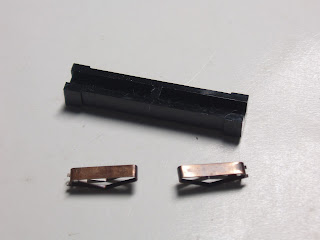

The battery charger is just a simple AC step down transformer that output about 10VAC when unloaded. This particular model has a switch to select between 110VAC or 230VAC.
It seems like HP is very determined to cut the cost of manufacturing down by incorporating a part of the AC 110/230V AC selection switch into the printed circuit board. It is not a very reliable switch in terms of dust and contact resistant, but you normally dont switch it too often, perhaps only once when you first use it to adjust to local power supply voltage. However the assembly of the movable switch and the charger does call for a some dexterity from the factory operators which they found in abundance from the young workers in Singapore.
For the HP-21 calculator this is half rectified and feed to the circuits via a resistor. A half wave rectified AC of 9.9VAC will get about 4V DC, with the resistor this would have reduce the voltage further to operate the HP-21 or to charge the battery.

Interesting point to note is that electrical safety standard in the 1970s do not seems to mandate the use of a over current fuse or over temperature fuse in the AC step down transformer.

This charger have some intermittent connection problem. I disassembled it to check. There was cracks in the solder joint where the AC power pins connect to the transfromer AC input pins. This probably results from stress when the AC power pins where move too much. It seems that the power pins are not soldered at the grommets to probably anchored them. This causes rocking of the pins then the charger is plug in or remove from the wall power socket.
The screw posts of the charger case has also been cracked as a result of over tightening. So I have use epoxy to stabilised the cracks and at the same time epoxy glue to casing halves together. Interestingly HP may have intended the charger to be repairable so they fastened the casing together with screws instead of just thermal fusing the two halves together like what is done in todays battery charger, a testimony to the cheap labour available compare to material costs in the 1970s.







No comments:
Post a Comment